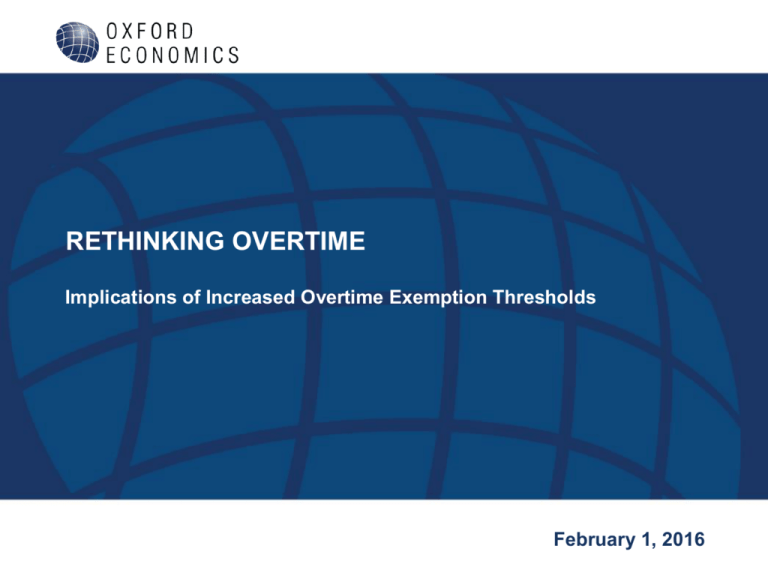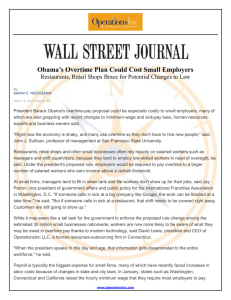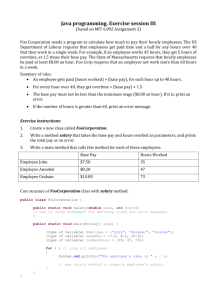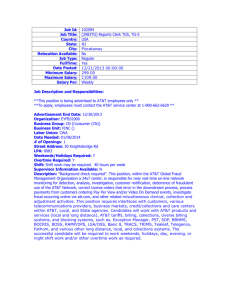nrf_oxford - U.S. Chamber of Commerce
advertisement

RETHINKING OVERTIME Implications of Increased Overtime Exemption Thresholds February 1, 2016 AGENDA AGENDA 1. INTRODUCTION 2. OBJECTIVES 3. BASICS OF THE OVERTIME EXEMPTION RULE 4. PROPOSED RULE CHANGE 5. ASSUMPTIONS 6. OUTCOMES 7. IMPLICATIONS 8. RECAP 2 INTRODUCTION INTRODUCTION The Department of Labor’s Wage and Hour Division (DOL) has proposed new regulations to the overtime pay rules under the Fair Labor Standards Act (FLSA). The new regulations are designed to expand the number of workers eligible to receive overtime pay through an increase in the salary threshold for the executive, administrative and professional (EAP) exemption, a.k.a. ‘white collar’ exemption. The rule also outlines a method for increasing the threshold annually. DOL anticipates that in the first year the new rule will affect 4.6 million currently exempt workers who earn less than the proposed new threshold of $50,440. Others put the estimate much higher. 3 OBJECTIVES OBJECTIVES OF THE PRESENTATION • Provide overview of proposed changes to the rule; • Illustrate how employers are likely to respond; • Highlight some specific issues associated with the design and outcomes of the proposed rule. 4 THE BASICS OF THE OVERTIME RULE THE BASICS How the rule works at the moment… • • FLSA establishes that workers are generally entitled to overtime pay unless they qualify for an exemption. FLSA sets three statutory requirements to be considered exempt from overtime under the white collar exemption: 1. Salary basis test: paid a pre-determined fixed salary. 2. Salary level test: must meet minimum specified amount— currently set at $455/week. 3. Duties test: must primarily involve executive, administrative or professional duties. 5 THE BASICS OF THE OVERTIME RULE THE BASICS And the changes that are proposed… • In July 2015, DOL issued a proposed overtime rule that would more than double the minimum salary threshold in 2016 and automatically increase the level every year thereafter. Current Proposed • Must earn $455 per week ($23,660 a year). • Must earn $970 per week ($50,440 a year). • This salary level is fixed until rule is revised. • This salary level is adjusted annually based on CPI-U or 40th percentile of FT salaried employees. • Must also pass duties and salary basis. • Duties test remains as is? 6 ASSUMPTIONS MISSING DOL ASSUMPTIONS DOL’s proposed rules do not adequately take into account how employers are likely to react, in particular businesses that are: 1. 2. 3. Highly competitive, price sensitive industries cannot easily absorb higher labor costs; Industries that have a tiered managerial structure and broad task/duty requirements (e.g. with many types of supervisory roles); Non-profit and public sector employers operate on fixed budgets and will not be able to passively absorb increased labor costs. DOL’s proposed rules also do not adequately take into account that employers have options for alternative compensation structures that they are likely to use rather than simply to pay more in labor costs—overtime or higher salaries. 7 ASSUMPTIONS OXFORD ECONOMICS’ BASELINE ASSUMPTION For-profit businesses in highly competitive markets, specifically retail and chain restaurants, report little wiggle room to adjust the price of products upward, even in the face of rising costs. To remain competitive and profitable in the long run, employers will use a variety of strategies to reduce labor costs that the proposed rule would seek to impose. 8 OUTCOMES OUTCOMES OF PROPOSED CHANGES What will happen to workers: • • In the face of increased labor costs spurred by external regulation, employers are likely to adopt different strategies to manage these costs. Three likely strategies are: 1. 2. 3. Compensation tradeoff Convert exempt, salaried non-exempt, hourly Reduced hours 9 OUTCOMES OUTCOMES OF PROPOSED CHANGES Compensation trade-off: Employers increase the salaries of workers near threshold to tip them over it, but other benefits are traded off to compensate • Currently exempt workers just below the $970/wk threshold will likely see their salaries increased. • However, bonuses, merit-based pay and other benefits will likely be adjusted to offset the increased cost. • In the retail and restaurant industry, for example, some 5% of the 2.2 million affected workers would likely see this outcome. 10 OUTCOMES OUTCOMES OF PROPOSED CHANGES Convert EAP salary workers to hourly, non exempt: Employers convert EAP salary workers to an hourly rate, set at a level that accounts for overtime that was previously exempt. • Currently-exempt workers well below the $970/wk threshold can expect to be converted from salaried to hourly, and become overtime eligible. • They can expect this to be at a level where their compensation (including overtime) is adjusted to mitigate an overall increase in wage bill. • Retail and restaurant industry: 21% of the 2.2 million affected workers would likely see this outcome = $11,600 increase in overtime, but little to no real income gain. 11 OUTCOMES OUTCOMES OF PROPOSED CHANGES Reduced hours: Employers reduce the hours of EAP workers well under $970/week and substitute with part-time labor. • Some currently exempt workers well below the $970/week threshold will likely be converted from salaried to hourly status and have their hours reduced to less than 40 per week (to minimize risk of overtime) and compensation reduced proportionally. • Part-time labor hired to offset losses in productivity. • In the retail and restaurant industry: 11% of the 2.2 million affected workers would have hours reduced and lose $2.3 billion in wages—used to hire approximately 117,100 part-time workers. 12 IMPLICATIONS IMPLICATIONS OF PROPOSED CHANGES Middle management (and middle class) squeeze: • Those in the middle, between $455/wk and $970/wk will likely be pushed toward non-exempt (hourly). This step back in careers will result in: • The loss of exempt perks, such as: workplace flexibility, training opportunities, benefits, and management ‘prestige’; • Becoming time-clock mandated and closely monitored; and • Means they are effectively ‘demoted’. • The consequence increased polarization of exempt vs. non-exempt as middle management is hollowed out. • Fewer middle management = restricted career path options and a more hierarchical workplace. Fewer opportunities for millennials exiting college: • Career-path opportunities erode in many industries that employ a variety of college-educated workers as salaried employees. 13 IMPLICATIONS IMPLICATIONS OF PROPOSED CHANGES Consequences will be geographically-differentiated: 14 IMPLICATIONS IMPLICATIONS OF PROPOSED CHANGES Annual adjustments to threshold—a cautionary tale: Proposal 1:Pegging to 40th percentile would change the pool of 40th percentile workers. Problems: • Change the pool of 40th percentile workers every year; • Risks creating a vicious cycle by compounding growth in 40th percentile earnings; • Forces employers to adjust more workers into non-exempt each year. Source: WorldatWork 15 IMPLICATIONS IMPLICATIONS OF PROPOSED CHANGES Annual adjustments to threshold: • Proposal 2: Pegging adjustment to inflation (CPI-U) Problem: Inflation moves at different rates leaves adjustment unpredictable year-over-year. $950 $900 $850 $800 $750 $700 $650 2000 2002 2004 2006 2008 CPI-U 2010 2012 2014 16 RECAP RECAP AND KEY TAKEAWAYS • • • • • • Employers will seek to minimize the impact on their wage costs: compensation trade-off, convert EAP to hourly, reduced hours. Hollows out middle management opportunities. Erodes career pathway opportunities—especially for millennials. Affects Southeast and other low-cost states more. Pegging the threshold to a percentile of salaried wages risks creating vicious cycle of compounding increases. Undermines the very intent of the proposed change in the first place. 17 EARLIER WORK RETHINKING OVERTIME: HOW INCREASING OVERTIME EXEMPTION THRESHOLDS WILL AFFECT THE RETAIL AND CHAIN RESTAURANT INDUSTRIES For more information: https://nrf.com/resources/retaillibrary/rethinking-overtime All data shown in tables and charts is Oxford Economics’ own data and is copyright © Oxford Economics Ltd, except where otherwise stated and cited in footnotes. The modeling and results presented here are based on information provided by third parties, upon which Oxford Economics has relied in producing its report and forecasts in good faith. Any subsequent revision or update of those data will affect the assessments and projections shown. 18 Q&A QUESTIONS AND ANSWERS 19 Europe, Middle East, and Africa: Global headquarters Oxford Economics Ltd Abbey House 121 St Aldates Oxford, OX1 1HB UK Tel: +44 (0)1865 268900 London Broadwall House 21 Broadwall London, SE1 9PL UK Tel: +44 (0)20 7803 1418 Belfast Lagan House Sackville Street Lisburn County Down, BT27 4AB Tel: + 44 (0)2892 635400 Paarl 12 Cecilia Street Paarl 7646 South Africa Tel: +27(0)21 863-6200 Frankfurt Mainzer Landstraße 41 60329 Frankfurt am Main Germany Tel: +49 69 95 925 280 Paris 25 rue Tiphaine 75015 Paris France Tel: +33 (0)1 56 53 98 52 Milan Via Cadorna 3 20080 Albairate (MI) Italy Tel: +39 02 9406 1054 Americas: New York 5 Hanover Square, 19th Floor New York, NY 10004 USA Tel: +1 (646) 786 1879 Philadelphia 303 West Lancaster Avenue Suite 2e Wayne, PA 19087 USA Tel: +1 (610) 995 9600 Mexico City Emerson 150, Despacho 802 Col. Polanco, Miguel Hidalgo México D.F., C.P. 11560 Tel: +52 (55) 52503252 Boston 51 Sawyer Rd Building 2 - Suite 220 Waltham, MA 02453 USA Tel: +1 (617) 206 6112 Hong Kong 30/F, Suite 3112 Entertainment Building 30 Queen’s Road Central Hong Kong Tel: +852 3103 1097 Chicago 980 N. Michigan Avenue, Suite 1412 Chicago Illinois, IL 60611 USA Tel: +1 (773) 372-5762 Sydney Level 4, 95 Pitt Street Sydney, 2000 Australia Tel: +61 (0)2 8249 8286 Miami 8201 Peters Road Suite 1000, Plantation, FL 33324 USA Tel: +1 (954) 916 5373 Email: mailbox@oxfordeconomics.com Website: www.oxfordeconomics.com San Francisco Tel: +1 (415) 870-5744 Asia Pacific: Singapore Singapore Land Tower 37th Floor 50 Raffles Place Singapore 048623 Tel: +65 6829 7198 20





